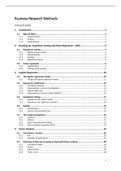Samenvatting
Summary Business Research Methods
- Instelling
- Katholieke Universiteit Leuven (KU Leuven)
Samenvatting van het vak Business Research Methods (Brushing up, logistic regression, factor analysis, reliability analysis, cluster analysis)
[Meer zien]



